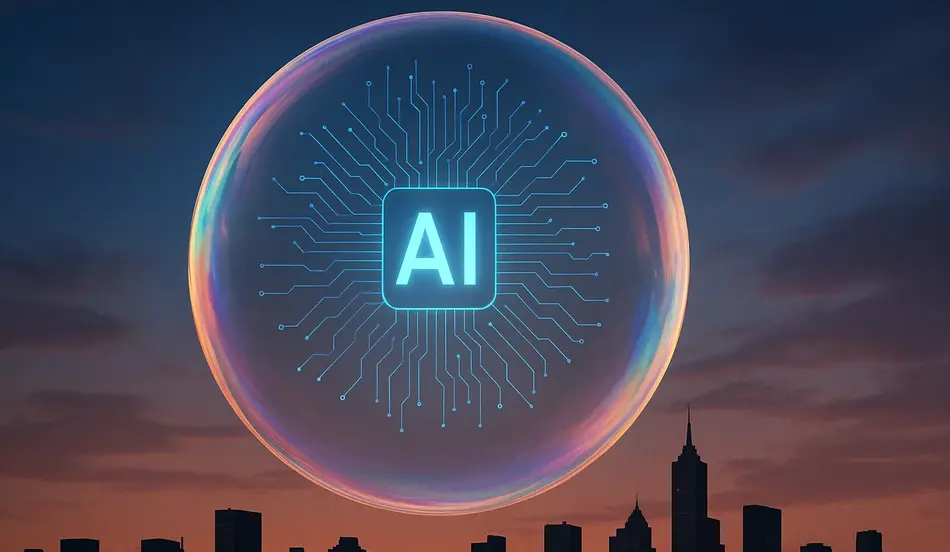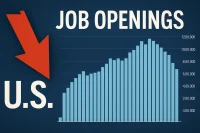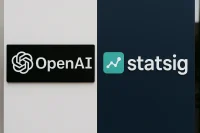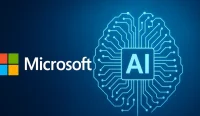The Half-Trillion Dollar AI Bet
The artificial intelligence revolution is not just transforming how we work and live – it’s reshaping the entire American economy through unprecedented levels of investment. Tech companies are pumping hundreds of billions of dollars into AI infrastructure, with some projections showing this spending may be fueling nearly half of this year’s estimated GDP growth. But as the AI gold rush accelerates, a critical question emerges: are we witnessing the birth of a new economic era, or are we caught in the middle of a dangerous bubble?
In Red Clay, West Texas, one piece of a half-trillion dollar bet stands as a testament to the scale of AI investment. An enormous data center complex from the creators of ChatGPT represents just one of hundreds of AI data centers sprouting nationwide. These extravagant bets, if they succeed, could pay off big time – but the stakes are enormous.
The comparison to historical technological revolutions is striking. “Imagine going back to the days when electricity was invented and making things happen 10 times faster,” says one Silicon Valley entrepreneur. “We could have automatic washing machines, we could have refrigerators, lots of things became possible with electricity.” AI represents the electricity revolution on steroids, with intelligence being added to everything and making business processes, data analysis, and operations smarter across the board.
The Enthusiasm and the Reality
The enthusiasm from tech moguls is palpable and widespread. “AI can take away the drudgery of the work and allow humans to provide the things that only a person can do – creativity, innovation,” says one industry leader. Companies are pledging massive investments: “We want to invest over $50 billion U.S. dollars in compute infrastructure and AI.” The sentiment is clear: “I think AI will be bigger than the internet.”
Since the release of ChatGPT in 2022, real and pledged spending by big tech has exploded. “We are spending hundreds of billions of dollars on AI architecture,” explains one finance professor at NYU’s business school. “There is a hope, a prayer that there is this big market out there for AI products and services.”
The Bubble Warning Signs
But is it just a prayer? Some industry experts are sounding alarm bells. “We are in the middle of an AI bubble,” warns one analyst. “There is no need for dozens of companies to have foundation models, and each are raising tens of billions of dollars training these large so-called foundation models.”
The AI boom reminds longtime entrepreneur Gary Kaplan of the auto industry at the dawn of the 20th century. “There were dozens of car companies eventually consolidating down to a few.” The same pattern emerged with search engines: “There was not a need for dozens of search engines. There was only a need for a small number and we are in the same situation today with AI.”
The consolidation reality is stark: “There is only a need for a handful of basic low-level foundation models that require all of this investment to build. What will happen? It is all going to consolidate obviously, and there will be only a few survivors left.”
Historical Precedents and Overinvestment
The pattern of overinvestment is not new. “There is a dream that maybe one day, we can make money from selling AI products and services just as we over invested for the internet at the start of the dot-com boom. We over invested in the PC architecture business before the PC boom. We over invested in social media at the start of the social media boom and I think we are overestimating how much money can be made from AI products and services.”
However, some argue that bubbles, while painful, drive innovation. “What is wrong with the bubble? Bubbles are terrible, they create pain and people lose money. Do you want to live in a world run by actuaries? Looking at fire in the caves saying it is dangerous, let’s have a few more years of testing. Every advance in humankind has come from overreach.”
The Economic Impact and Market Dependence
The economic impact is already significant. “50% of GDP is driven by AI,” according to some projections. The S&P 500 is up 10% this year, largely thanks to tech stocks and AI investments. “This is a market that is on the back of AI for the last couple years. The stocks might be down 40% and that does have ripple effects on the economy. Losing $10 trillion in market cap in five companies can have huge consequences for people’s 401(k)s and their spending.”
The Labor Market Disruption
AI’s impact on the labor market is proving particularly disruptive. Many booming companies are not adding workers as they usually do – they’re shedding them. “We went from 5000 to 3000. If you look at jobs, they are shrinking,” says the CEO of a buy-now-pay-later firm. The pattern is consistent across industries: “10 years ago I did a story on coding academies. Now, profitable companies, very profitable, are laying off those people.”
The impact extends to even the most qualified workers. “Many students have considerable difficulty getting jobs and I’m talking about students graduating with masters degrees in computer science. That is tremendous.” The disruption isn’t limited to Silicon Valley: “Artificial intelligence will replace literally half of all white-collar workers in the U.S.,” predicts the Ford CEO in Michigan. “AI will leave a lot of white-collar people behind.”
Hiring for the Next Tech Wave?
Tech giants are betting big on AI — and the demand for forward-thinking talent has never been higher. Post your job on WhatJobs today and tap into the surge of AI-minded professionals.
Post a Job Now →The Promise and Peril of AI
Despite the job displacement concerns, AI’s potential benefits are undeniable. “AI can analyze patterns and with it, I will revolutionize the medical diagnostic industry. My goal is to be able to provide full comprehensive medical testing for less than the cost of a meal.” The technology promises to “improve the world immeasurably” through better healthcare, more efficient processes, and enhanced decision-making capabilities.
However, the downside is equally real. “AI will take jobs on a scale we can’t imagine. Many new jobs will appear, but a lot of existing jobs that do grunt work, many will analysis of stuff in manual labor, will be eliminated because of what AI makes possible.” The transformation is “unstoppable” but comes with significant risks.
The Dual Nature of AI Progress
AI represents a technology with both utopian and dystopian potential. “I talk about the good side, I can use it to solve medical diagnostics and reduce suffering but at the same time it will take jobs away and create new nightmares. Security issues, deepfakes, god knows what. None of us really understand how fast things are moving.”
The speed of change is unprecedented, and the implications are far-reaching. We’re not even discussing the nightmare scenarios from science fiction – the rogue AI operating independently – but the real-world consequences are already profound and accelerating.
The Economic Reality Check
The fundamental question remains: is this AI investment boom sustainable, or are we witnessing another bubble that will eventually burst? The historical pattern suggests caution. Every major technological revolution has been accompanied by overinvestment, followed by consolidation and, often, significant economic disruption.
The current AI boom differs from previous technological revolutions in its scale and speed. The half-trillion dollar investment represents a massive bet on an unproven market, with companies racing to build infrastructure before demand is fully established. This creates the classic bubble conditions: massive investment, high expectations, and uncertain returns.
Conclusion: The Lord Giveth, the Lord Taketh Away
As one observer notes, “The lord giveth, the lord taketh away.” This biblical reference perfectly captures the dual nature of the AI revolution. The technology promises to transform industries, improve lives, and create unprecedented economic value. At the same time, it threatens to displace millions of workers, create economic instability, and potentially burst in a spectacular fashion.
The AI investment bubble represents both the greatest opportunity and the greatest risk facing the American economy today. Whether it leads to sustained prosperity or economic disruption depends on how well we manage the transition, invest in worker retraining, and ensure that the benefits of AI are broadly shared rather than concentrated among a few tech giants.
The stakes couldn’t be higher. The half-trillion dollar bet on AI will either reshape the economy for the better or leave us with another painful lesson about the perils of technological overreach. Only time will tell which outcome we’re heading toward.
Frequently Asked Questions
How much are tech companies investing in AI infrastructure?
Tech companies are investing over $500 billion in AI infrastructure, with some projections showing this spending may fuel nearly half of this year’s estimated GDP growth.
Are we experiencing an AI investment bubble?
Many experts believe we are in the middle of an AI bubble, with dozens of companies raising tens of billions to train foundation models when only a handful will likely survive the inevitable consolidation.
How is AI affecting the job market?
AI is causing significant job displacement, with many profitable companies laying off workers instead of hiring, and even computer science master’s graduates having difficulty finding employment.
What are the potential benefits and risks of AI investment?
Benefits include revolutionizing medical diagnostics, improving business processes, and creating new economic opportunities. Risks include massive job displacement, market volatility, and the potential for a bubble burst that could impact 401(k)s and economic stability.
Live Example: A Real-World Impact
Consider the story of a Stanford computer science master’s graduate who, despite having one of the most in-demand degrees, is struggling to find employment in the current AI-driven market. This student represents thousands of highly qualified workers who are being displaced by the very technology they were trained to work with. Meanwhile, tech companies are investing hundreds of billions in AI infrastructure while simultaneously reducing their human workforce, creating a paradox where technological advancement leads to job elimination rather than creation.




